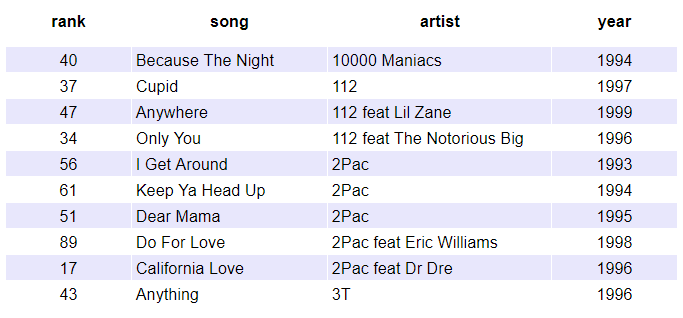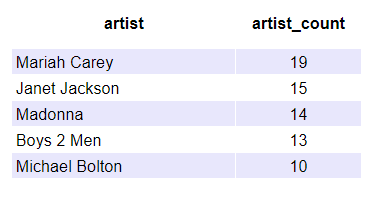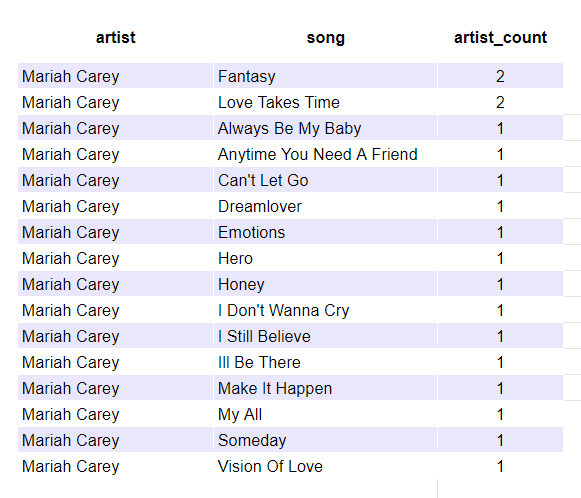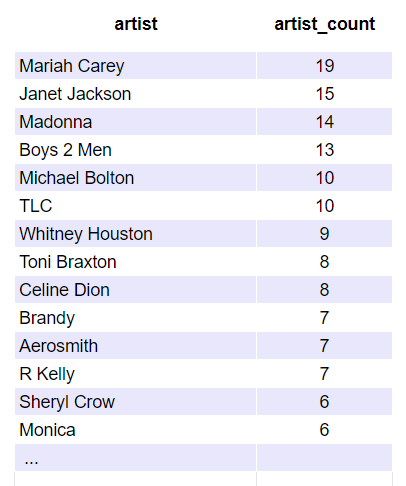Your data comes alive when you aggregate it. By using only one or two functions on a standard table, you can build metrics and answer questions about the data. As the terminology is similar to pivot tables and Excel functions, you’ll be up and running in no time.
Introduction
COUNT all the things
COUNT DISTINCT
GROUP BY
ORDER BY
GROUP BY multiple columns
HAVING
Types of functions available
Introduction to aggregate functions
In this example, I’m going to be using a subset of the Billboard Top 100 dataset, available on Kaggle. I grew up in the 90s so I’ve loaded the 90s rows into a table called music_charts in SQL Server. To answer any of my burning questions about 90s music and who was at the top of the charts I’m going to need to use aggregate functions.
|
1 2 |
select top 10 * from dbo.music_charts |

COUNT all the things
The first way to explore this dataset is to COUNT how large it is. This is similar to the COUNT function in Excel and works in the same way.
This function counts up all the rows and returns, in this case, 1000 to the results window. 100 rows per year over 10 years. It’s all there and ready to go.
|
1 2 |
select count(*) as table_count from dbo.music_charts |
COUNT DISTINCT
Next up, I want to see how many artists are in the table. I can see that there are duplicates where an artist reached the top of the charts more than once.
This has returned a COUNT of 545 DISTINCT artists from the table. It still isn’t super useful so we need to add more columns.
|
1 2 |
select count(distinct artist) as artist_count from dbo.music_charts |
Filtering with GROUP BY
It’s nice to have some facts and figures, but it would be more useful to answer some questions like ‘which artist featured the most across the top 100 charts in the 1990s?’
Similar to a pivot table in Excel, we can do this by adding more columns. However, it’s not quite as simple as just dropping in a column. If we run this query we get an error.
We need to explicitly say that we want all the artists to be collapsed down into one row with the count in the artist_count column next door. We do this using GROUP BY.
|
1 2 3 4 5 6 7 8 9 |
select artist, count(artist) as artist_count from dbo.music_charts /* Msg 8120, Level 16, State 1, Line 1 Column 'dbo.music_charts.artist' is invalid in the select list because it is not contained in either an aggregate function or the GROUP BY clause. */ |

|
1 2 3 4 5 |
select artist, count(artist) as artist_count from dbo.music_charts group by artist |
ORDER BY
This is getting close but needs one more clause to answer my question. By ordering by the artist_count we can see that Mariah Carey appears the most in the dataset. Naturally.
|
1 2 3 4 5 6 7 |
select top 5 artist, count(artist) as artist_count from dbo.music_charts group by artist order by artist_count desc, artist |
GROUP BY multiple columns
Now we have the hang of the syntax we can start drilling into the data further and answering questions like ‘Which Mariah Carey songs featured more often in the Top 100 charts in the 90s?’
|
1 2 3 4 5 6 7 8 9 |
select artist, song, count(artist) as artist_count from dbo.charts where artist = 'mariah carey' group by artist, song order by artist_count desc, song, artist |
HAVING
The last thing to cover off is HAVING. This allows us to put a condition on the aggregate. This is different from using a WHERE that puts a condition on individual rows.
To better illustrate how this works let’s use an example where we want to see who has featured on the list more than five times.
We count up the number of artists and then use HAVING as the last step to filter on the count.
|
1 2 3 4 5 6 7 |
select artist, count(artist) as artist_count from dbo.music_charts group by artist having count(*) > 5 order by artist_count desc |
Types of functions available
But it doesn’t stop with counting things.
The basic functions used day to day in SQL Server are:
- COUNT,
- MIN,
- MAX,
- SUM,
- AVG
So you can use aggregate functions to slice and dice the 90s however you like.
Photo by Sarah Chai from Pexels






Comments are closed, but trackbacks and pingbacks are open.